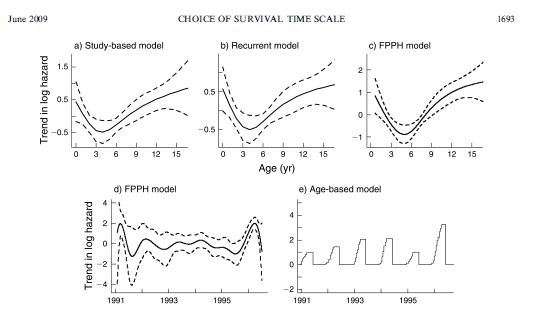Flexible time-to-event models are needed to quantify relationships between climatic variation and important demographic processes. The effect of time-varying exposures may change abruptly depending on cumulative exposure patterns; more work is needed to develop methods that can recover these complex relationships. My interest in this area has been fostered while researching methods for estimating smooth hazard functions that describe changes in mortality patterns along multiple time scales (e.g., age, Julian date) [1,4-7], and while demonstrating the usefulness of these methods for analyzing migration data [2,3].
1. DelGiudice, G.D., J. Fieberg, M. C-Powell, M.R. Riggs, and W. Pan. 2006. A long-term age-specific survival analysis of female white-tailed deer. Journal of Wildlife Management 70:1556-1568.
2. Fieberg, J., D. W. Kuehn, and G. D. DelGiudice. 2008. Understanding variations in autumn migration of northern white-tailed deer by long-term study. Journal of Mammalogy 89:1529-1539.
3. Fieberg, J. and G. D. DelGiudice. 2008. Exploring migration data using interval-censored time-to-event models. Journal of Wildlife Management 72:1211-1219.
4. Fieberg, J., and G. D. DelGiudice. 2009. What time is it? Choice of time origin and scale in extended proportional hazards models. Ecology 90:1687-1697.
5. Lenarz, M. S., J. Fieberg, M. W. Schrage, and A. J. Edwards. 2010. Living on the edge: viability of moose in northeastern Minnesota. Journal of Wildlife Management 74:1013-1023.
6. Fieberg, J. and G. D. DelGiudice. 2011. Estimating age-specific hazards from wildlife telemetry data. Journal of Environmental and Ecological Statistics 18:209-222.
7. Severud, W. J., Obermoller, T. R., Delgiudice, G. D., & Fieberg, J. R. 2019. Survival and cause‐specific mortality of moose calves in northeastern Minnesota. The Journal of Wildlife Management, 83(5), 1131-1142.
